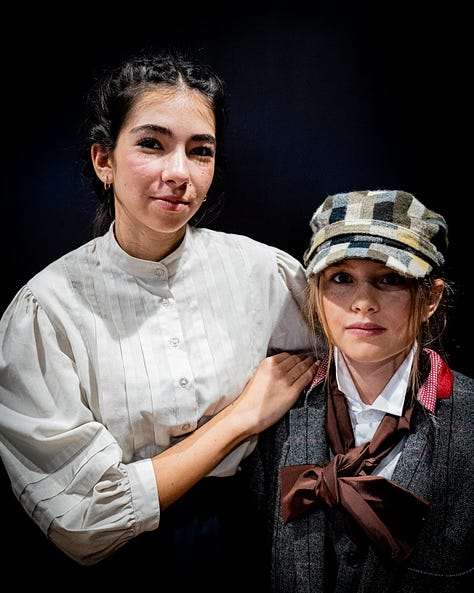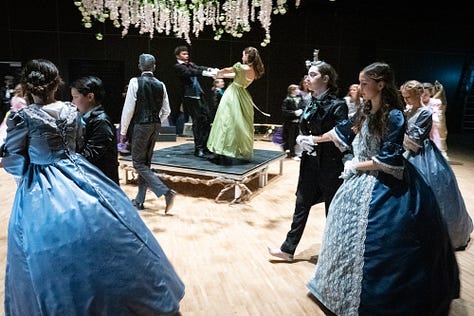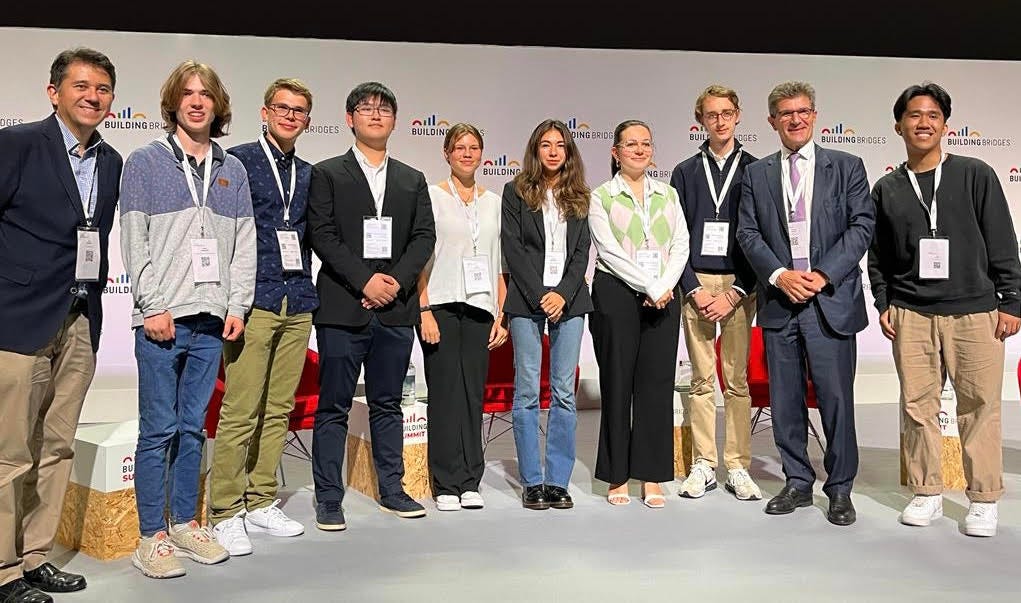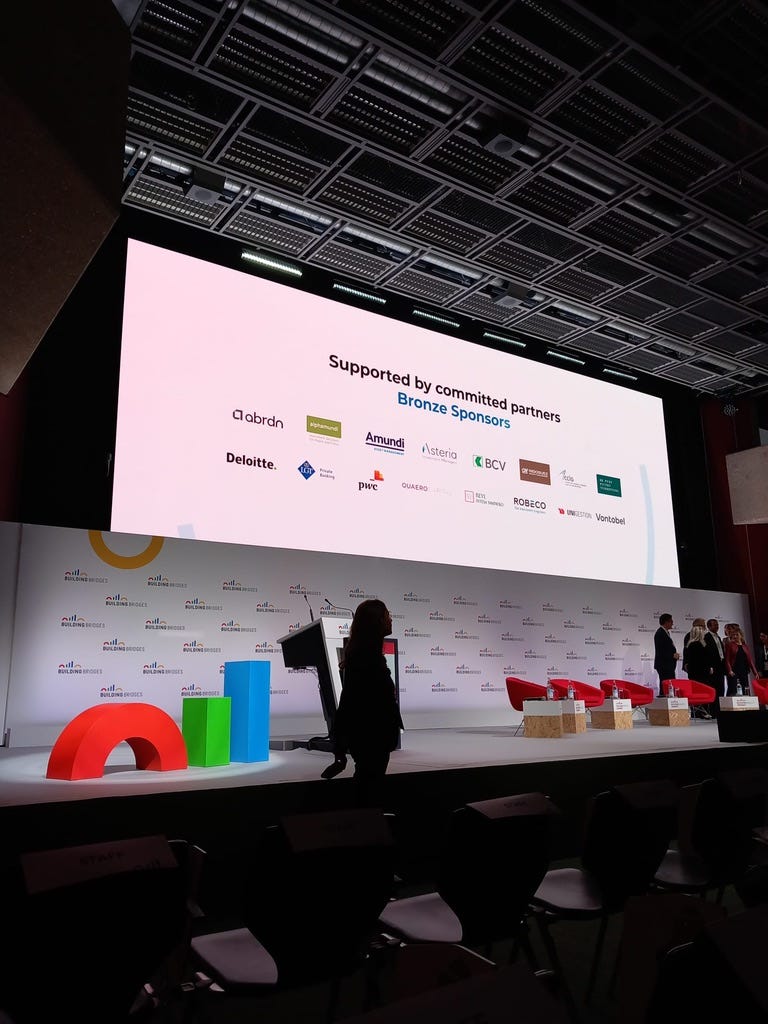Welcome back, everyone! My name is Jovana, I hope you figured that out based on the title. If you don’t know who I am (go read my first newsletter!), the simplest way for me to introduce myself is: I am a 15-year-old girl participating in The Knowledge Society who is very passionate about brain-computer interfaces and climate action. Aaand…. I also love to paint, do high jump, and long jump, play basketball, go on walks, and run… this is me!
So what did you learn from that? Nothing really, just what I “come across as”, but that doesn’t say much about me though. Personality wise, experiences, etc….These last two months I have definitely learned a lot, especially writing better newsletters and how to convey who I really am to all of you!
Not only did I learn a lot but I’ve also been all over the place and swamped with responsibilities! From attending a finance and sustainability panel to participating in a school play. Perfect isn’t it? Because, what makes a better reflection than two busy months? Let’s jump all the way back to October…
October
Building Bridges
3rd-4th of October.
Through the Villars Institute (a sustainability symposium I attended in the summer) alongside 7 other Villars fellows, I was invited to attend the Building Bridges Summit in Geneva. Throughout the summit, we attended various panels all focusing on transitioning the financial system to one that is more sustainable.
Building Bridges is more than an event, it is a powerful movement that aims to accelerate the transition to a sustainable financial system.
The Building Bridges summit brought together various experts from different fields in finance and/or sustainability to discuss and present what has to be done/what is being done to make that vital transition.
“Creates space for us to get to know each other, understand each other’s perspectives, and speak each other's languages” -Patrick Odier, president of Building Bridges.
However, this was not always the case. The panelists could either:
a) Talk about the transition to sustainability.
b) Talk about the transition to sustainability in terms of their own company.
c) Talk about the “transition” to sustainability while indirectly promoting their own company.
And option “c” happened A LOT more than I expected. Throughout my 2 days in Geneva, I didn’t just learn about sustainability and finance but also how media-trained many of the presenters were in promoting their companies. A win-win situation for me though, where I got to know more about how the“real world” works. It was interesting (a little contradictory to the summit) when the executives/experts started talking about how their company reduced x and y while the answer was not even related to the question:
a) “What do you think, how can we all illustrate to our customers that it is essential to become more sustainable”
b) “You see that is a very good point. In my company (x) we have currently reduced CO2 emissions by y% over the last two years”
Woah that is great. Now can you please answer the question? This happened so often and it was clear that the rest of the Villars fellows and the people around us were genuinely frustrated, especially when the questions asked came directly from the audience members.
On a brighter note, here are some of the panels that really stuck with me after leaving the summit:
Just Transition
A “just transition” is a transition to sustainability that encompasses everyone’s needs. For example, why don’t we just put an end to all coal mines because of how unsustainable they are? Well, we have to consider the people. What would happen to those workers? Or the stakeholders? What other jobs would these people need if the coal mines were closed? One sustainable transition results in a cascading domino effect on all of the people dependent on it (in this case the coal mines).
AFOLU
Agriculture Forestry and other Land Use.
By 2030, we aim to decrease agricultural land by 10%, but how will the growing population be fed with less land? The Earth can be divided up so:
Earth’s surface: 29% land and 71% water.
Land’s surface: 71% habitable land.
Habitable land: 50% agriculture.
Agriculture land by practice: 98% conventional farming (harmful to the environment) and only 2% organic.
This is crazy. Earth provides almost a third of its land possible for habitation, and one-half of that is used for agriculture! The half that is used for agriculture has almost 100% of it being utilized in harmful ways.
In a discussion with Paul Polman
One of the last, and most important panels where Polman puts the disastrous effects we have on the planet into perspective.
“Humans have been around for 4 hours, the Industrial revolution started 1 minute ago, and in that one minute, we cut down half of the earth’s forests”
He brought up a very important example of necessasry but limited improvement. For example, stating “Carbon emissions were 100 million but now are 60 million“. Both of these are hugely catastrophic numbers. When shocking the boundaries of the climate so badly then anything better seems amazing, when in reality it is the same as saying “I used to kill 10 people, but now I only kill 6”.
“At the end of the day, it’s not the issue of technology, financing, or climate change. The real issues we are dealing with are human greed and unapathy.”
He finished the discussion by reminding all of us that we cannot have healthy humans on an unhealthy planet.
The Knowledge Society (TKS) Hackathon
During October in TKS, we spent so much time going over important mindsets to have later in life. This I will elaborate on after the November section. However, arguably even more exciting was the hackathon.
The goal of the hackathon is to solve a big problem while practicing the mindset that done is better than perfect. My group and I chose to tackle the clean water shortage and we were inspired by the flood crisis in Pakistan.
According to UNICEF, “An estimated 70 percent of households still drink bacterially contaminated water.”
We wanted to find a way to harness the positive side of the floods, which led us to create our solution.
We designed a tube that can be moved to the flood site and is stable to stand on its own. The tube sucks the flood water and filtrates it with the use of nanomembranes. The tube can be attached to a water tank where the water is stored and later transported to the people. Our solution was then named “water drop”. (Check out our website!).
Throughout the process we struggled with:
creating an idea: our final idea was okay but could have been more innovative. It was quite unoriginal because nanomembrane filtration systems already exist, all we did was incorporated a tube system.
creating the slideshow for the presentation: It was our first time creating “more professional” slides for a project and we included too few words that didn’t benefit us during the presentation.
Using time effectively: we wasted a lot of our time when we called each other to “work on the project”. We would often get distracted and do anything but work on the hackathon, such as talk about how our day has been. All a lot of fun though!
The hackathon was a great learning experience and a very fun way to work on ideation, teamworking, and presentation skills.
November
A Christmas Carol Performance
From the end of September to the end of November I took part in a school performance based on A Christmas Carol. We took a spin on it, and instead of performing it on a stage, the audience followed the actors around the school (immersive performance). Getting into this I had no idea what to expect! I had done 4 years of theater in and out of school but never participated in such a big-scale performance. Not to mention that this one was done with 10 to 17-year-olds. It was SO MUCH work. Rehearsals 3x a week, and every Sunday the rehearsals would be 8 or even 11 hours long!
Reflecting on it, however, I can see that the whole commitment was definitely worth it. It was very entertaining and I became friends with so many different people! Here are my biggest takeaways from the show:
Time management: With half of my weekends gone because of the play, and a majority of the rest of it taken up by sports and TKS it was so important that I learned to manage my time. I blocked out times that I would work on my assignments and made sure to never leave anything for the last minute. This was a skill that I took on after the play was over as well, and made me feel like I had so much time for myself.
Done is better than perfect: With so little time to work on school, I really practiced the done > perfect mindset. I had to finish assignments or understand the material. Not perfect every single thing on them and memorize the whole textbook. The time commitment taught me to prioritize what is most important.
Patience: Let me tell you that working with kids 4-5 years younger than me was one of the HARDEST things I have ever done. Especially knowing that the reasons our rehearsals were so long is because questions would be repeated every 5 minutes, or the younger kids would not pay attention (only a certain few). At the start of the long rehearsals, I was always moody, thinking I could be spending my time better. However, as the performance date approached I learned to have more patience with the younger grades and make the most of my time by having some fun.



No surprise I improved my acting a lot. That was the most enjoyable part. Over the course of the whole two months, the acting in my scene jumped from a 20 to a 90! I’m not even exaggerating (I am exaggerating). The process made me realize that even though acting in plays is a lot of hard work, it’s completely worth it.
The Knowledge Society (TKS)
A lot has happened. I’ve made progress on my focus (main scale project in TKS) on brain-computer interfaces (BCI). More specifically, I published my first article about it called BCI changing the future of dreams. The creation process was very tedious, I had to research for SO LONG before finding all of the information I wanted to include in the article. Turns out BCIs in the field of dreams hadn’t been around for so long (no big shock here). If this is an area of interest for you, go check the article out! Even if it isn’t… it definitely will be after learning more about it!
The mentalities (mindsets) that we have practiced take second place in the most interesting things I have done in TKS for the past two months (yes even more than the focus).
I’ll share my top two with you and my biggest takeaways from them (Why not three? well, because I don’t like odd numbers. Just kidding, because these two really stood out to me).
Appreciation:
This is a very important mindset and one that is looked over way too often. Appreciation is confused with gratitude all of the time. Do you know what the difference is?
Gratitude is a feeling, an internal emotion where we acknowledge that we are thankful for something. Appreciation is an action, we are showing our gratitude.
So why and how should we be appreciative?
Being appreciative (showing gratitude) is very important because it makes people feel better about themselves and lets them feel recognized. It’s the recognition of the good qualities in a person. You should take action and ask yourself “how do you make someone feel appreciated?”. If you are feeling gratitude, then act on it! Never deny the urge to be kind.
Life and success:
This one was less of a mindset and more of a change in perspective where we redefined what success is and how to get there. It is so important to understand that every person has a different meaning of success.
Let’s start by thinking back: what did success look like 100,000 years ago? To survive, reproduce, and survival of the fittest. This is not what success looks like now (to most people at least).
But how exactly do you know what success means to you? Your success should align with your core principles of values, skills, and interests. Most importantly you should have a vision. Set goals and achieve them. Conventionally, people believe that to become successful you need to finish college, get a well-paying job and settle down with enough money. However, this isn’t successful for everyone, some people might want to travel, while others to learn about the world.
My biggest takeaway from this mindset is to not let other people define what success means to me.
I am continuing to work on my focus and will create an EEG BCI system with various different parts that I ordered! Expect to read more about it in my December newsletter! Until then you can find me on:
Thank you for reading my newsletter and I hope to see you around!











Very well written and articulated